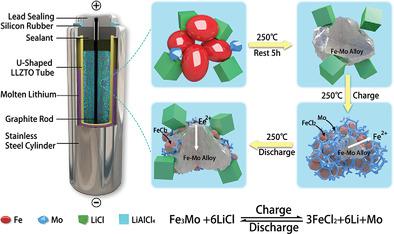当前位置:
X-MOL 学术
›
Adv. Mater.
›
论文详情
Our official English website, www.x-mol.net, welcomes your
feedback! (Note: you will need to create a separate account there.)
A Garnet-Type Solid-Electrolyte-Based Molten Lithium-Molybdenum-Iron(II) Chloride Battery with Advanced Reaction Mechanism.
Advanced Materials ( IF 27.4 ) Pub Date : 2020-06-23 , DOI: 10.1002/adma.202000960
Jing Xu 1 , Kai Liu 2 , Yang Jin 1 , Bin Sun 1 , Zili Zhang 1 , Yi Chen 3 , Dawei Su 3 , Guoxiu Wang 3 , Hui Wu 2 , Yi Cui 4, 5
Advanced Materials ( IF 27.4 ) Pub Date : 2020-06-23 , DOI: 10.1002/adma.202000960
Jing Xu 1 , Kai Liu 2 , Yang Jin 1 , Bin Sun 1 , Zili Zhang 1 , Yi Chen 3 , Dawei Su 3 , Guoxiu Wang 3 , Hui Wu 2 , Yi Cui 4, 5
Affiliation

|
Solid‐electrolyte‐based molten‐metal batteries have attracted considerable attention for grid‐scale energy storage. Although ZEBRA batteries are considered one of the promising candidates, they still have the potential concern of metal particle growth and ion exchange with the β”‐Al2O3 electrolyte. Herein, a Li6.4La3Zr1.4Ta0.6O12 solid‐electrolyte‐based molten lithium−molybdenum−iron(II) chloride battery (denoted as Li−Mo−FeCl2) operated at temperature of 250 °C, comprising a mixture of Fe and LiCl cathode materials, a Li anode, a garnet‐type Li‐ion ceramic electrolyte, and Mo additive, is designed to overcome these obstacles. Different from conventional battery reaction mechanisms, this battery revolutionarily synchronizes the reversible Fe−Mo alloying−dealloying reactions with the delithiation−lithiation processes, meaning that the porous Mo framework derived from Fe−Mo alloy simultaneously suppresses the growth of pure Fe particles. By adopting a Li anode and a Li‐ion ceramic electrolyte, the corrosion problem between the cathode and the solid electrolyte is overcome. With similar battery cost ($12 kWh−1), the theoretical energy density of Li−Mo−FeCl2 battery surpasses that of a Na−FeCl2 ZEBRA battery over 25%, to 576 Wh kg−1 and 2216 Wh L−1, respectively. Experimental results further prove this cell has excellent cycling performance (472 mAh gLiCl−1 after 300 cycles, 50 mg active material) and strong tolerance against the overcharge−overdischarge (3−1.6 V) and freezing−thawing (25−250 °C) incidents.
中文翻译:

具有高级反应机理的石榴石型固态电解质基熔融锂-钼-铁(II)氯化物电池。
固体电解质基熔融金属电池在电网规模的储能方面引起了相当大的关注。尽管ZEBRA电池被认为是有前途的候选产品之一,但它们仍然具有金属颗粒生长以及与β” -Al 2 O 3电解质进行离子交换的潜在隐患。在此,使用Li 6.4 La 3 Zr 1.4 Ta 0.6 O 12固体电解质基氯化锂-钼-铁(II)熔融电池(表示为Li-Mo-FeCl 2)在250°C的温度下运行,旨在克服这些障碍,其中包含Fe和LiCl阴极材料的混合物,Li阳极,石榴石型Li-ion陶瓷电解质和Mo添加剂。与传统的电池反应机理不同,该电池革命性地将可逆的Fe-Mo合金化脱合金反应与去锂化过程同步化,这意味着源自Fe-Mo合金的多孔Mo骨架同时抑制了纯Fe颗粒的生长。通过采用锂阳极和锂离子陶瓷电解质,可以克服阴极与固体电解质之间的腐蚀问题。在类似的电池成本($ 12 kWh -1)下,Li-Mo-FeCl 2电池的理论能量密度超过Na-FeCl 2的理论能量密度ZEBRA电池超过25%,分别达到576 Wh kg -1和2216 Wh L -1。实验结果进一步证明了这电池具有优异的循环性能(472毫安克的LiCl -1 300次循环,50毫克活性物质之后)和较强的耐受力对抗过充电过放电(3-1.6 V)和冻融(25-250℃下)事件。
更新日期:2020-08-11
中文翻译:

具有高级反应机理的石榴石型固态电解质基熔融锂-钼-铁(II)氯化物电池。
固体电解质基熔融金属电池在电网规模的储能方面引起了相当大的关注。尽管ZEBRA电池被认为是有前途的候选产品之一,但它们仍然具有金属颗粒生长以及与β” -Al 2 O 3电解质进行离子交换的潜在隐患。在此,使用Li 6.4 La 3 Zr 1.4 Ta 0.6 O 12固体电解质基氯化锂-钼-铁(II)熔融电池(表示为Li-Mo-FeCl 2)在250°C的温度下运行,旨在克服这些障碍,其中包含Fe和LiCl阴极材料的混合物,Li阳极,石榴石型Li-ion陶瓷电解质和Mo添加剂。与传统的电池反应机理不同,该电池革命性地将可逆的Fe-Mo合金化脱合金反应与去锂化过程同步化,这意味着源自Fe-Mo合金的多孔Mo骨架同时抑制了纯Fe颗粒的生长。通过采用锂阳极和锂离子陶瓷电解质,可以克服阴极与固体电解质之间的腐蚀问题。在类似的电池成本($ 12 kWh -1)下,Li-Mo-FeCl 2电池的理论能量密度超过Na-FeCl 2的理论能量密度ZEBRA电池超过25%,分别达到576 Wh kg -1和2216 Wh L -1。实验结果进一步证明了这电池具有优异的循环性能(472毫安克的LiCl -1 300次循环,50毫克活性物质之后)和较强的耐受力对抗过充电过放电(3-1.6 V)和冻融(25-250℃下)事件。

































 京公网安备 11010802027423号
京公网安备 11010802027423号